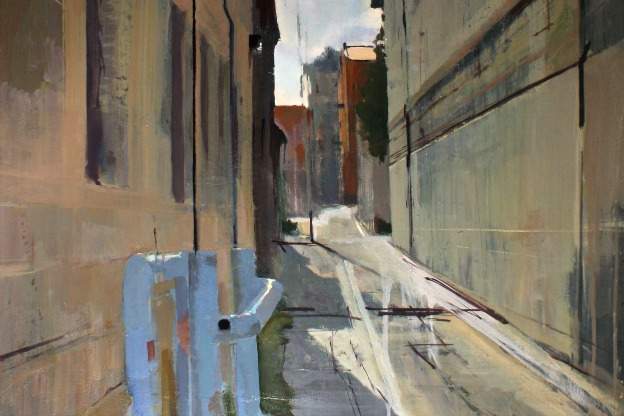
Over the last decade I have occasionally noticed a landscape or a nude in a group show at one or another Bloomington gallery that has drawn me in with its achingly beautiful light, and an ethereal, wistful quality combined with the suggestion of a strenuous infrastructure.
Following Mark Ratzlaff's career has been challenging-prior to his current show at Blueline Gallery, his last solo exhibition was held in 2005. Born and raised in Springfield, Missouri, Ratzlaff spent time in New York and Italy before moving to Bloomington in 2001, where he has shown at Gallery West, Wandering Turtle, and The Gallery, among other venues.
As it turns out, Ratzlaff's desultory approach is not confined to the painter's career path. When asked to describe his working process, the painter demurs.
"There is no process!" he insists. "That's the key. Every time that I've tried something that makes senseI'm going to do a preliminary drawing, I'm going to layer the paint like thisit comes out dead, it's flat, it's boring, it's not me. There has to be some chance involved. I have to wing it on some level."
It's a misleadingly casual remark. In tandem with his intermittent exhibition history, one might assume that the painter was less than serious.  But that's far from the case.
Undivided Attention
"His intensity and his engagement with the work is in the painting and in the drawing," curator Jim Andrews avers, "which is what attracts me."
Andrews curated Ratzlaff's current show after having known him for years.
"He asked me to sit for him," Andrews recalls, "and I'd watch him just go at that canvas and keep looking at me, keep taking a measurement with his pencil. He was very committed to what he was doing at that moment, he was fully engaged."
That complete dedication to the process of translating what's before him to the surface is something Ratzlaff admires in Jean-Baptiste-Camille Corot, one of his earliest painting heroes. "He was the first influence in the way I structure a landscape," Ratzlaff acknowledges.
One of the pioneers of plein-air landscape painting, Corot's approach anticipated the devotion to passing effects of light evinced by the Impressionists. But distilling one's immediate retinal impressions was not as easy as it might appear.
"I was reading his letters," Ratzlaff explains, "where he wrote about how he was so exhausted that he couldn't go out with his friends at night, because he'd been painting all day."
When Zhi Lin, Ratzlaff's professor at Missouri State University, took his class to a Corot exhibition in Kansas City, Ratzlaff was stunned to see how small the paintings were that had required such labor. "They were tinythe size of a clipboardbut beautiful, little achieved landscapes."
Elusive Immediacy
In Ratzlaff's own drawings and paintings-mostly cityscapes and nudes-that quest for immediacy is similarly hard-won.
"You have to work hard to get that immediate look," Ratzlaff explains, "it's actually a struggle. If you can get something that's immediate, immediatelythat's amazing. It's so rare though. Underneath something that looks immediateeven in [the paintings of John Singer] Sargentthere's going to be labor. It's as if you have to go through all this work to get that immediacy; you really have to know your subject or have already gotten intimate with your subject."
And although that word choice might seem to point to the nudes-many young, female, and beautiful-there is an implied intimacy in the alleyways, parking lots and stretches of sidewalk Ratzlaff devotes his attention to-a close relationship that is not without emotion.
In a letter to a friend, Elizabeth Bishop wrote, 'What it is that we're looking for in a work of art is what went into its making, and that is a perfectly useless, self-forgetting attention.'Â So just being arrested, visually, is really worth it.
"I wouldn't have shown up to paint this specific thing if it didn't affect me on some level,"Â he concedes.
"He's not very keen onwhat shall we sayconveying emotion," Andrews offers. "He wants it as pure as he can get it. But fortunately, it's messy enough, impure enough. It's just very personal work and I think that that grabs the viewer."
Still, Ratzlaff goes all painterly when pressed directly about the content of his work, or what he's trying to convey.
"I just try to build a composition," Ratzlaff claims, "and capture the light, you know. Experience the space."
"It's really enough," Andrews suggests, "to have your attention arrested and forget yourself so you're experiencing something that art has to give youwhich is not a narrative, or a political message. And it's enough to do that because you're being really human at that moment. In a letter to a friend, Elizabeth Bishop wrote, 'What it is that we're looking for in a work of art is what went into its making, and that is a perfectly useless, self-forgetting attention.' So just being arrested, visually, is really worth it."
"It's more than enough!" Ratzlaff chimes in. " I mean this is everything...this is it!"






